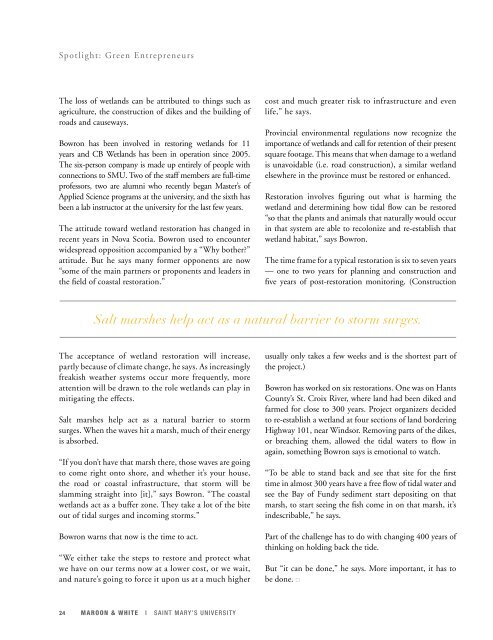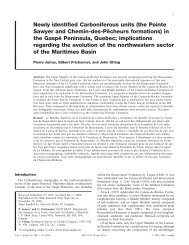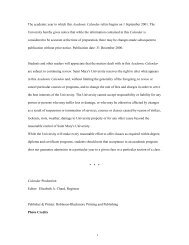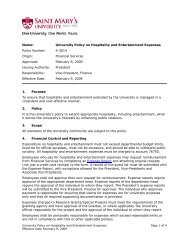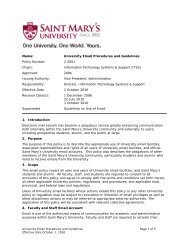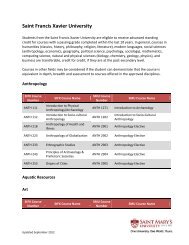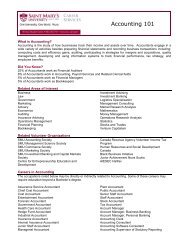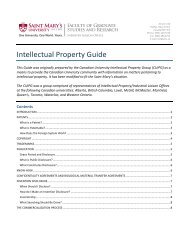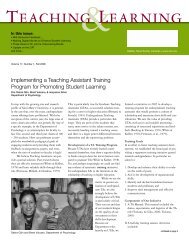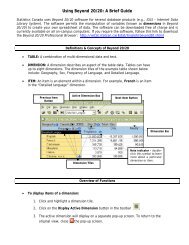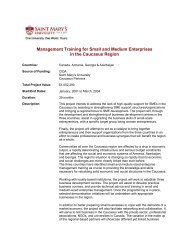Steven Estey - Saint Mary's University
Steven Estey - Saint Mary's University
Steven Estey - Saint Mary's University
Create successful ePaper yourself
Turn your PDF publications into a flip-book with our unique Google optimized e-Paper software.
Spotlight: Green Entrepreneurs<br />
The loss of wetlands can be attributed to things such as<br />
agriculture, the construction of dikes and the building of<br />
roads and causeways.<br />
Bowron has been involved in restoring wetlands for 11<br />
years and CB Wetlands has been in operation since 2005.<br />
The six-person company is made up entirely of people with<br />
connections to SMU. Two of the staff members are full-time<br />
professors, two are alumni who recently began Master’s of<br />
Applied Science programs at the university, and the sixth has<br />
been a lab instructor at the university for the last few years.<br />
The attitude toward wetland restoration has changed in<br />
recent years in Nova Scotia. Bowron used to encounter<br />
widespread opposition accompanied by a “Why bother?”<br />
attitude. But he says many former opponents are now<br />
“some of the main partners or proponents and leaders in<br />
the field of coastal restoration.”<br />
The acceptance of wetland restoration will increase,<br />
partly because of climate change, he says. As increasingly<br />
freakish weather systems occur more frequently, more<br />
attention will be drawn to the role wetlands can play in<br />
mitigating the effects.<br />
Salt marshes help act as a natural barrier to storm<br />
surges. When the waves hit a marsh, much of their energy<br />
is absorbed.<br />
“If you don’t have that marsh there, those waves are going<br />
to come right onto shore, and whether it’s your house,<br />
the road or coastal infrastructure, that storm will be<br />
slamming straight into [it],” says Bowron. “The coastal<br />
wetlands act as a buffer zone. They take a lot of the bite<br />
out of tidal surges and incoming storms.”<br />
Bowron warns that now is the time to act.<br />
“We either take the steps to restore and protect what<br />
we have on our terms now at a lower cost, or we wait,<br />
and nature’s going to force it upon us at a much higher<br />
24 MAROON & WHITE I SAINT MARY’S UNIVERSITY<br />
cost and much greater risk to infrastructure and even<br />
life,” he says.<br />
Provincial environmental regulations now recognize the<br />
importance of wetlands and call for retention of their present<br />
square footage. This means that when damage to a wetland<br />
is unavoidable (i.e. road construction), a similar wetland<br />
elsewhere in the province must be restored or enhanced.<br />
Restoration involves figuring out what is harming the<br />
wetland and determining how tidal flow can be restored<br />
“so that the plants and animals that naturally would occur<br />
in that system are able to recolonize and re-establish that<br />
wetland habitat,” says Bowron.<br />
The time frame for a typical restoration is six to seven years<br />
— one to two years for planning and construction and<br />
five years of post-restoration monitoring. (Construction<br />
Salt marshes help act as a natural barrier to storm surges.<br />
usually only takes a few weeks and is the shortest part of<br />
the project.)<br />
Bowron has worked on six restorations. One was on Hants<br />
County’s St. Croix River, where land had been diked and<br />
farmed for close to 300 years. Project organizers decided<br />
to re-establish a wetland at four sections of land bordering<br />
Highway 101, near Windsor. Removing parts of the dikes,<br />
or breaching them, allowed the tidal waters to flow in<br />
again, something Bowron says is emotional to watch.<br />
“To be able to stand back and see that site for the first<br />
time in almost 300 years have a free flow of tidal water and<br />
see the Bay of Fundy sediment start depositing on that<br />
marsh, to start seeing the fish come in on that marsh, it’s<br />
indescribable,” he says.<br />
Part of the challenge has to do with changing 400 years of<br />
thinking on holding back the tide.<br />
But “it can be done,” he says. More important, it has to<br />
be done. <br />
2010<br />
Alumni Awards<br />
The 2010 Alumni Awards were presented during the President’s Wine & Cheese Reception as part of<br />
Homecoming 2010. The recipients were nominated by their peers, colleagues and friends. For further<br />
details on each award, please visit www.smu.ca/alumni/a_awards.html<br />
The Father William A. Stewart, S.J., Medal for Excellence in Teaching:<br />
Dr. Barry Gorman, Accounting Department<br />
Associate Alumni Membership:<br />
Donna Filek<br />
Alumni Volunteer of the Year Award:<br />
Kathy Naulls (Assoc’08) and Paul Hollingsworth (BA’94)<br />
Distinguished Community Service Award:<br />
Dr. John A.P. Sullivan (BSc’69) and Fr. George Leach, posthumously (HS’54)<br />
Young Alumni Award:<br />
Khalid Waleed Alkhudair (BComm ’07)<br />
photo: (left to right) Dr. John A.P. Sullivan (Bsc’69), Kathy Naulls (Assoc’08), Paul Hollingsworth (BA’94), Donna Filek,<br />
and Dr. Barry Gorman.<br />
MAROON & WHITE I SAINT MARY’S UNIVERSITY 25


